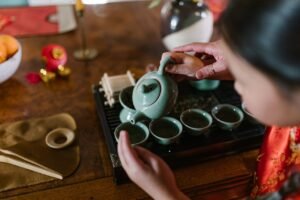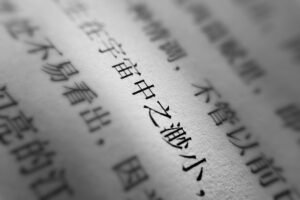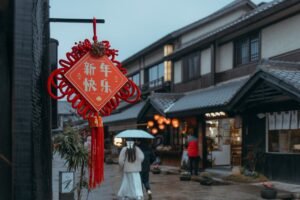Throughout this article, you will be introduced to some of the most famous Chinese instruments. You’ll pick up helpful vocabulary and learn more about traditional Chinese culture.
In ancient China, a wide variety of musical instruments were employed. There are more than 3,000 years behind many of these instruments. Of the most popular instruments, you find gǔ zhēng 古筝 – zither. the dí zi 笛子 – bamboo flute, pí pá 琵琶 – a plucked stringed instrument with a fretted fingerboard, the èr hú 二胡 – Southern Fiddle and the gǔqín 古琴.
Table of Contents
Toggle1 GǓ ZHĒNG 古筝 - GUZHENG OR ZITHER
The gǔ zhēng 古筝 is a large zither with 13 to 25 strings. The instrument was developed from gǔqín 古琴 during the Tang and Song dynasties.
During the Qing dynasty, it remained popular both in the Imperial court and among the general populace, and it is still played today in China.
Chinese opera and concert performances frequently feature the gǔ zhēng 古筝.
According to tradition, this instrument is played by a female musician. The players always wear fingerpicks made of plastic, resin, or other materials. The gǔ zhēng 古筝 players frequently perform on their own. Pinching the strings is a standard method of playing heptatonic notes and chords on the instrument.
古筝是中国古老而独特的民族乐器之一。
Gǔzhēng shì Zhōngguó gǔlǎo ér dútè de mínzú yuèqì zhī yī.
The gǔ zhēng 古筝 is one of the ancient and unique national musical instruments in China.
我想学古筝,你可以教我吗?
Wǒ xiǎng xué gǔzhēng, nǐ kěyǐ jiāo wǒ ma?
I want to learn to play the gǔ zhēng 古筝, can you teach me?
古筝曾在秦国(今陕西)盛行,至今已有2000多年的历史Gǔzhēng céng zài qín guó (jīn Shǎnxī) shèngxíng, zhìjīn yǐ yǒu 2000 duōnián de lìshǐ.The gǔ zhēng 古筝 was already very popular in the Qin State (now Shaanxi), and up until now, it has had a history of more than 2,000 years.
2 DÍ ZI 笛子 - DIZI, BAMBOO FLUTE
The dí zi 笛子 is a Chinese style flute, usually made of bamboo. The instrument usually has six holes and is held horizontally.
The dí zi 笛子 is a popular instrument in China because it is a relatively simple instrument to learn to play. It is often used in various Chinese folk music and opera genres.
Because the dí zi 笛子 is simple to make and transport, it is popular among Chinese students and fans of traditional folk music. There are several different types of dí zi 笛子 flutes, distinguished primarily by their length. The longer ones allow for deeper tones to be produced.
笛子是中国最古老的乐器,有3000多年的历史。
Dízi shì zhōngguó zuì gǔlǎo de yuèqì, yǒu 3000 duōnián de lìshǐ.
The dízi 笛子 is the oldest musical instrument in China, with a history of more than 3,000 years.
3 PÍ PÁ 琵琶 - PIPA (A PLUCKED STRINGED INSTRUMENT WITH A FRETTED FINGERBOARD)
The pí pá 琵琶 is a traditional Chinese instrument with a 2000-year history, making it one of the oldest instruments in China. The pí pá 琵琶, also known as a “Chinese Lute” in English, is a four-stringed instrument with 16 frets.
Because of the wide dynamic range of notes, the pí pá 琵琶 is frequently used to create expressive and dramatic pieces of music.
The pí pá 琵琶 is also known as the “king of plucked string instruments” in China.
In recent years, the pí pá 琵琶 has been re-engineered to be more compatible with Western-style music. Players now use finger plectra instead of traditional strings because steel strings are being used. In most cases, pí pá 琵琶 musicians can perform on stage or provide entertainment at special events or restaurants
.我妈妈弹得一手好琵琶。Wǒ māmā tán de yīshǒu hào pípá.My mother plays the pí pá 琵琶 very well.

4 ÈR HÚ 二胡 - ERHU, ALSO CALLED SOUTHERN FIDDLE
You will almost certainly come across the èr hú 二胡 during your China travels. In public places, subway stations, and streets in China, you’ll frequently see amateurs and street musicians practising their craft.
The èr hú 二胡 is a type of Chinese-style violin with two strings that dates back to the Tang Dynasty (the 7th to 10th centuries).
Compared to other traditional Chinese instruments, it is a relatively low-cost option. In the past, the èr hú 二胡 was only used in opera and orchestral performances, but it has become increasingly popular as a solo instrument.
The èr hú 二胡 generally maintains its traditional tuning system, which allows for a high level of virtuosity. The instrument has a three-octave range and can be played to imitate Chinese singing sounds, birds and horses, among other things. It emits a melancholy tone when played.
二胡拥有一千多年的历史,是中国独特的弦乐器。
Èrhú yǒngyǒu yīqiān duō nián de lìshǐ, shì zhōngguó dútè de xiányuèqì.The èr hú 二胡 has a history of more than a thousand years and is a unique stringed instrument in China.
5 GǓQÍN 古琴 - GUQIN
The gǔqín 古琴 is a plucked instrument with seven strings, similar to the zither in appearance. The gǔqín 古琴 is believed to have been used for 3000 years, making it one of the oldest instruments in China. It is frequently referred to as “The Father of Chinese Music”.
Many great scholars and musicians favour the gǔqín 古琴 because it is capable of producing sounds of great subtlety and refinement. The gǔqín 古琴 is said to have been one of Confucius’ – Kǒngzǐ 孔子 favourite instruments to use when teaching his students. By the Chinese, the gǔqín 古琴 is regarded as an “Instrument of the Sages” and a representative of traditional Chinese musical culture.
古琴是中国传统的弹拨乐器,已有3000多年的历史。
Gǔqín shì zhōngguó chuántǒng de tánbō yuèqì, yǐ yǒu 3000 duōnián de lìshǐ.The gǔqín 古琴 is a traditional Chinese plucked stringed instrument with a history of more than 3,000 years.
古琴是汉族最早的弦乐器,是汉文化中的瑰宝
Gǔqín shì hànzú zuìzǎo de xiányuèqì, shì hàn wénhuà zhōng de guībǎo.
The gǔqín 古琴 is the earliest stringed instrument of the Han people and a treasure in the Han culture.
We hope you enjoyed this article. Learning new Chinese vocabulary is essential whether you study Chinese in Canada, study Chinese in Shenzhen or study Chinese at Tsinghua University. As China is a country, it is helpful to know the history and traditional culture of Chinese to communicate well with Chinese people.
DO YOU WANT TO LEARN MORE MANDARIN CHINESE OR KNOW SOMEONE WHO WANTS TO?
If you want to learn Mandarin Chinese, feel free to REGISTER FOR A FREE TRIAL CLASS HERE or send me an email (Chen Huimin): huimin@laerkinesisk.no.
We offer private lessons and group classes at all levels, HSK 1-6, children, adults, business. All Mandarin Chinese classes are offered in classrooms or online.
Do you know anyone who wants to learn Chinese? We will give you 500 US dollars as a bonus as a part of our program “Refer a friend – get $ 500” if your friend or others you introduce to us start taking Chinese classes at our school. Register here if this is interesting for you!









